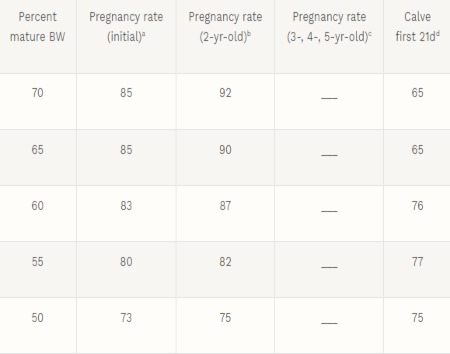By Josie Crouch and Kacie McCarth
This article is a research summary of the 2024 Nebraska Beef Report, Impact of Heifer Percent Mature Body Weight at Breeding on Heifer Performance, Calf Production, and Subsequent Pregnancy Rates.
To remain in the herd, it is crucial for a replacement heifer to conceive and maintain pregnancy. However, since females within a herd offset input costs with a live calf born each year, focus should not only be placed on pregnancy rates as a yearling, but subsequent pregnancy rates as a cow.
The traditional recommendations have heifers reaching 65% of their mature body weight by breeding to maximize pregnancy rates. However, multiple studies across various regions have shown heifers developed as low as 48% mature body weight at breeding showed no impact on reproduction.
These studies have been conducted over 3 years or less, which may limit the ability to interpret results. However, developing heifers to a lower percentage of mature body weight at breeding could potentially serve as a management strategy to reduce input costs without sacrificing performance. This study determined how differing heifer percent mature body weights (50, 55, 60, 65, and 70%) at breeding affected heifer performance, calf performance, and subsequent pregnancy rates.
This study used data collected from 2005 through 2019 at the University of Nebraska, Gudmundsen Sandhills Laboratory using 1,434 March- and May-calving Red Angus x Simmental crossbred heifers and cows.
Conclusions and Implications
During the development period, it is crucial to make management decisions that focus not only on initial performance, but also on how subsequent performance may also be impacted (ex. plane of nutrition, high versus low rate of gain, natural service versus artificial insemination). Producers should consider developing heifers in a way that optimizes reproductive performance and best encompasses the goals of their operation, rather than striving for a specific target weight.
Calculations
The average herd mature body weight from the March- and May-calving herds were calculated by the average body weight of 5, 6, and 7-year-old cows at weaning, with weight being adjusted to a common body condition score of 5. The average weights for March and May cows were 1,107 and 1,072 lbs., respectively.
To determine heifer actual mature body weight percentages within the breeding groups, heifers’ recorded body weights at breeding were divided by their respective herd average mature body weight. March-calving heifers were at an average of 60% mature body weight at breeding, with a range of 42% to 85%. Heifers in the May-calving breeding ranged from 46% to 92% mature body weight at breeding with an average of 67%.
A retrospective regression analysis was conducted on percent of estimate mature body weight to determine predicted responses of initial pregnancy rates, subsequent pregnancy rates (2-, 3-, 4-, and 5-year-old cow), and calf production at differing heifer mature body weight percentages. Differences in calving season, year, and when the heifer was born in the calving season were all accounted for in the statistical analysis.
Results
See Table 1 for specific numbers associated with each group of heifers. In general:
- A greater percentage of mature body weight at breeding showed higher pregnancy rates as heifers and as 2-yr-olds.
- Percent mature body weight of heifers at breeding had no impact on subsequent pregnancy rates after 2 years of age.
- Heifers at a lower percentage of mature body weight at breeding had a greater percent that calved in the first 21 days of the calving season.
- As heifer percent mature body weight increased, subsequent calf birth and weaning body weights increased, by 1.2 lbs and 5 lbs, respectively, per 5% BW increase at breeding.
Table 1: Summary of impacts percent mature body weight (BW) at breeding has on performance.

- Heifers at a greater percent of mature BW at breeding (60-70%) had greater initial pregnancy rates.
- Heifers at a greater percent of mature BW at breeding (60-70%) had greater pregnancy rates as a 2-year-old.
- Heifer mature BW percentage at breeding had no impact on pregnancy rates as a 3, 4, 5-year-old.
- Heifers at a lower percent of mature BW at breeding (50-60%) had a greater percent calve in the first 21d.
Source : unl.edu